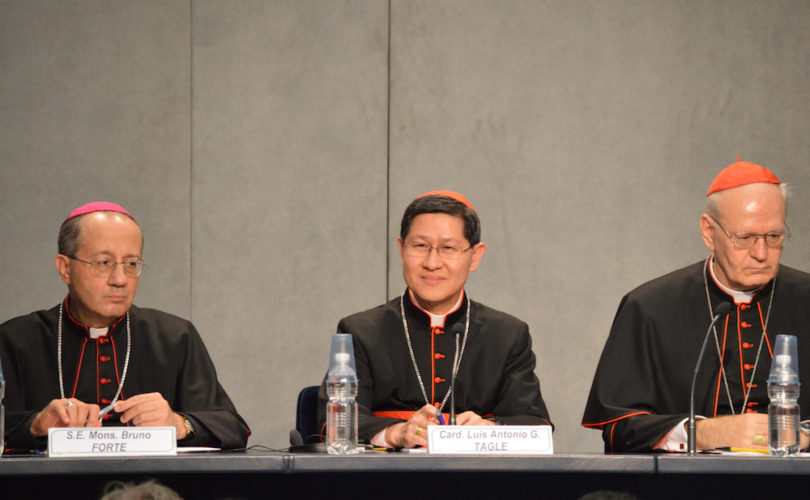LifeSiteNews has been permanently banned on YouTube. Click HERE to sign up to receive emails when we add to our video library.
July 22, 2021 (LifeSiteNews) – In his Letter to Bishops accompanying his Apostolic Letter Traditionis Custodes, among many things worthy of comment Pope Francis says that Pope Paul VI:
“declared that the revision of the Roman Missal, carried out in the light of ancient liturgical sources, had the goal of permitting the Church to raise up, in the variety of languages, ‘a single and identical prayer,’ that expressed her unity. This unity I intend to re-establish throughout the Church of the Roman Rite.”
This is a puzzling statement. First, “the Church of the Roman Rite” has many other liturgical books besides the standard edition of the Roman Rite. Second, the standard Roman Missal contains an enormous number of options, and hardly seems to be aiming at uniformity of prayer in the sense which seems to be intended in Pope Francis’ new letter. Third, the Second Vatican Council and the subsequent Papal Magisterium teach that liturgical uniformity is not necessary to the unity of the Church, but rather that the latter is best expressed in liturgical diversity.
On the first point, the Latin or Western Church does not have a single Missal, but a family of Rites or Uses. These include the very ancient Mozarabic Rite, celebrated in certain places in Spain, the Ambrosian Rite celebrated in Milan, and the Carthusian Rite, celebrated in Carthusian monasteries. These three Rites were revised after Vatican II. Then there are the Rites of the Dominicans, the Norbertines, and the Carmelites: these orders adopted the Roman Rite after Vatican II so there is no reformed version, but since their liturgical books were never suppressed, members of those orders can and do still celebrate them. Then there is the new Use of the Ordinariate, which includes elements of Anglican liturgical heritage, which was promulgated as recently as 2009.
Perhaps the odd phrase “the Church of the Roman Rite” is supposed to suggest that the necessary uniformity applies only to the distinction between the Ordinary and Extraordinary Forms of the Roman Rite. But if uniformity is necessary for unity in a theological sense within the Roman Rite, why is it not necessary for those cousins of the Roman Rite that I have just listed, and indeed what is it about the non-Roman Rites which make it possible for them to maintain unity without uniformity?
This becomes more puzzling still in light of the second point. The Roman Missal of 1970 and subsequent editions does not direct priests to use the same words when celebrating Mass, even if they are doing so in the same language, because of its enormous number of options. Priests are frequently at liberty to use different propers (an “Optional Memorial” or Votive Mass instead of the “Ferial” Mass), and they can also choose different options for other parts of the Mass. The argument of the Letter to Bishops not only suggests that there is something problematic about the existence of the Ambrosian Rite and the Ordinariate Use, but it also suggests there is something problematic about having multiple Eucharistic Prayers.
Despite the attempt to limit the implications of the Letter’s argument that unity requires liturgical uniformity to the Roman Rite, it is a deeply disturbing idea for Orthodox Christians, including those engaged in ecumenical dialogue with the Catholic Church.
In truth, there is nothing theologically problematic about liturgical variety in itself because even quite different Rites are still expressions of a single prayer in the important theological sense: the prayer of Christ in offering himself to the Father. As Pope Paul VI expressed it, continuing the snippet quoted by the Letter, “one unique prayer will rise as an acceptable offering to our Father in heaven, through our High-Priest Jesus Christ, in the Holy Spirit” (Apostolic Constitution Missale Romanum 1969, Vatican website translation).
This brings me to the third point: the teaching of Vatican II. Consider its document Sacrosanctum Concilium (4): “holy Mother Church holds all lawfully acknowledged rites to be of equal right and dignity; that she wishes to preserve them in the future and to foster them in every way.”
Again (37): “Even in the liturgy, the Church has no wish to impose a rigid uniformity in matters which do not implicate the faith or the good of the whole community.”
Another document of Vatican II, Orientalium Ecclesiarum (2), affirms that “the variety within the Church in no way harms its unity; rather it manifests it”, and this idea has been reiterated in the later Magisterium. For example, Pope John Paul II explained that “we find the strength and enthusiasm to intensify the quest for harmony in that genuine plurality of forms which remains the Church’s ideal” (Orientale Lumen (1995) 2).
The Catholic Church is bigger than the Roman Rite, and the Roman Rite is bigger than just one set of words. It is ironic that all the ancient Roman Rites and Usages in use today, despite their other differences, all have the same Eucharistic Prayer, in Latin, showing their unity not only across space but also across the generations, connecting us with the earliest Latin liturgy of Rome. This symbolic unity does not exist in the reformed Missal, which the Letter apparently wants to make the basis of a sterile liturgical uniformity.



